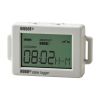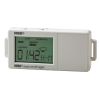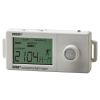HOBO UX90 Light On/Off Data Logger
Features
- Auto-calibration of ON and OFF thresholds
- User-adjustable sensitivity control for low/high light level conditions
- Expedited repair and warranty service
- Lifetime technical support
- More
Overview
The Onset HOBO UX90 Light on/off logger monitors indoor light changes with an internal sensor and records light on/off conditions; ideal for building energy audits and light usage analysis.
Memory
This logger is available in a standard 128 KB memory model (UX90-002) capable of 84,650 measurements and an expanded 512KB memory version (UX90-002M) capable of over 346,795 measurements.
| Light Threshold |
> 65 lux |
| Light Type |
LED, CFL, fluorescent, HID, incandescent, natural |
| Start Modes |
Immediate, push button, date & time, or next interval |
| Stop Modes |
When memory full, push button, or date & time |
| Power Source |
One 3V CR2032 lithium battery and USB cable |
| Battery Life |
1 year typical use |
| Memory |
UX90-002: 128 KB (84,650 measurements, maximum) UX90-002M: 512 KB (346,795 measurements, maximum) |
| Download Type |
USB 2.0 interface |
| Full Memory Download Time |
10 seconds for 128 KB; 30 seconds for 512 KB |
| Logger Operating Range |
Logging: -20° to 70°C (-4° to 158°F); 0 to 95% RH (non-condensing) Launch/Readout: 0° to 50°C (32° to 122°F) per USB specification |
| LCD |
LCD is visible from: 0° to 50°C (32° to 122°F); the LCD may react slowly or go blank in temperatures outside this range |
| Size |
3.66 x 5.94 x 1.52 cm (1.44 x 2.34 x 0.6 in.)
|
| Weight |
23 g (0.81 oz)
|
| Environmental Rating |
IP50 |
| Memory Modes |
Wrap when full or stop when full |
- HOBO UX90-002x Light On/Off Data Logger
- Command™ strip
- Double-sided tape
- Hook & loop strap
In The News
Three Decades of Research at Acton Lake
A multi-disciplinary team at Miami University, Ohio, has been studying the environmental change at Acton Lake for over three decades. Using three different NexSens buoys over this time, the team has an incredible archive of data that is helping build a picture of Acton’s past, present, and future. Until recently, a NexSens CB-50 buoy was used alongside other environmental monitoring at Acton Lake. In May 2025, the Miami team deployed a new XB-200 buoy , future-proofing their ongoing monitoring using real-time buoy systems. Acton Lake, a small hypereutrophic reservoir in southwest Ohio, covers 2.4km² and has a maximum depth of about 8m. The dam was built in 1956, and the lake has a large agricultural watershed.
Read MoreSource Water Monitoring in Albany, New York: Tracing Water Quality throughout Tributaries
Thousands of US cities pull their drinking water from natural source waters like reservoirs, rivers, and streams, making overall watershed health a key consideration for water providers. In Albany, New York, the Albany Department of Water and Water Supply delivers drinking water to over 100,000 residents as well as monitors and manages the larger drinking water supply watershed. Hannah Doherty, Environmental Specialist at the Albany Department of Water and Water Supply , spends her days working with a small team to monitor the drinking supply and the connected water bodies. Doherty explains, “We’re the first to encounter the water that ends up being the drinking water.
Read MoreWildfire Prevention in the Sierra Nevada Region with the Yuba Watershed Institute
Though recent wildfires have sparked new conversations about wildfire management and response, groups like the Yuba Watershed Institute have been monitoring the forests and water resources of the Sierra Nevada region for decades, managing approximately 5,000 acres of land with the Bureau of Land Management (BLM) and about 7,000 acres in private land partnerships. The goal of the Institute is to work with local communities and land agencies to improve watershed and forestry management through informed practices and public outreach. The goals of the Yuba Watershed Institute are three-fold: Improve the ability of fire suppression agencies like the California Department of Forestry and Fire Protection ( CAL FIRE ) and the US Forest Service.
Read More














